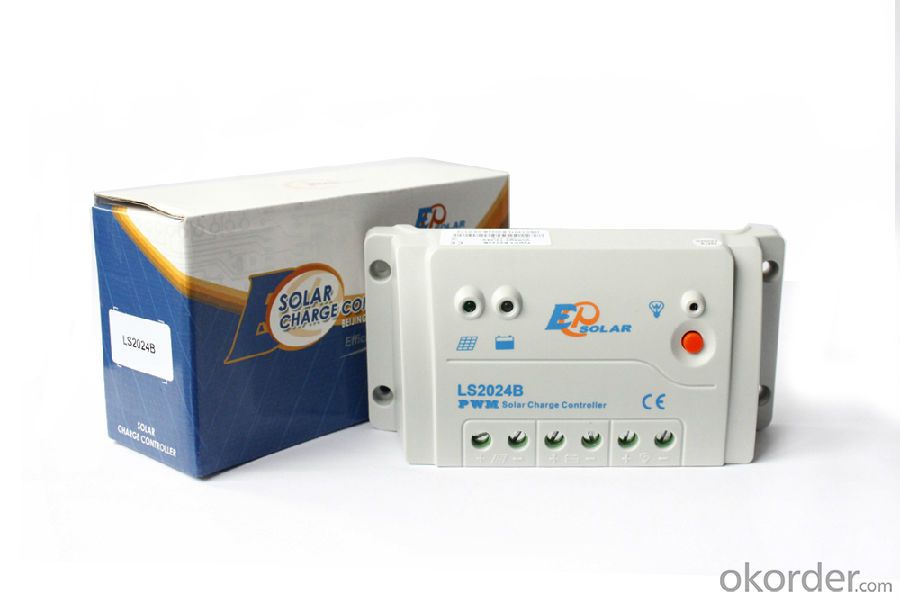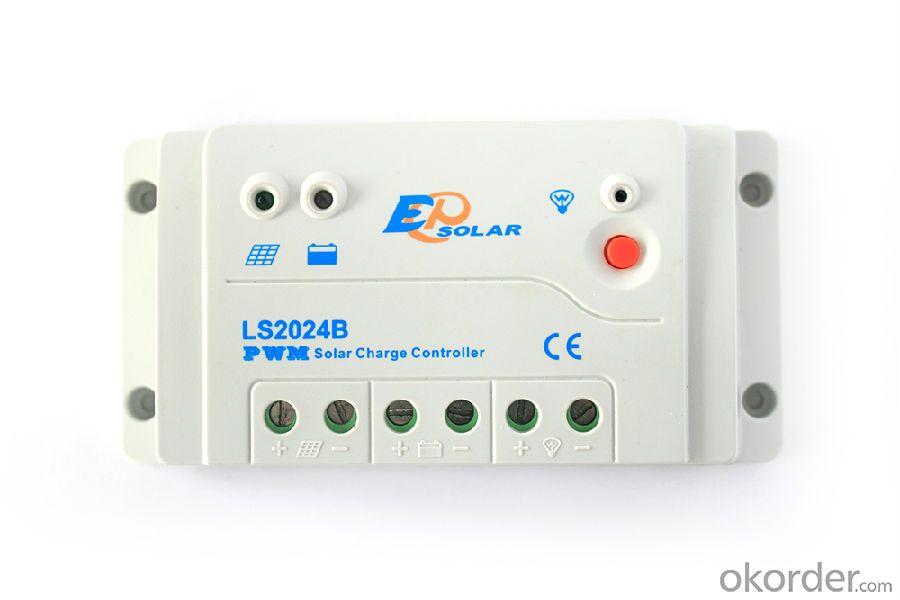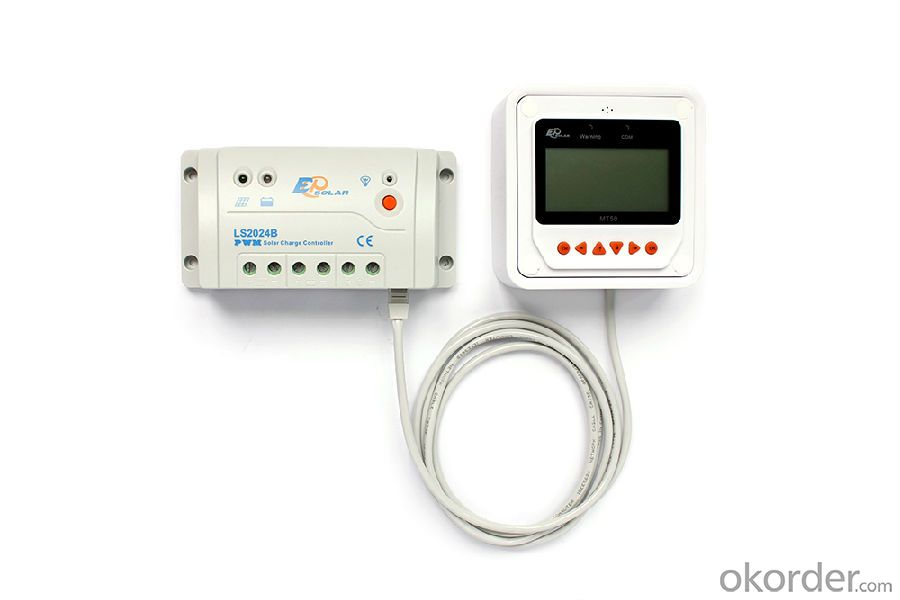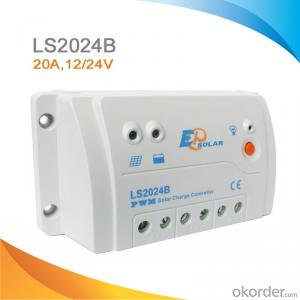PWM Solar Charge Controller,20A 12/24V,LS2024B
OKorder Service Pledge
OKorder Financial Service
You Might Also Like
Descriptions:
A charge controller, or charge regulator is basically a voltage and/or current regulator to keep batteries from overcharging. It regulates the voltage and current coming from the solar panels going to the battery. Most "12 volt" panels put out about 16 to 20 volts, so if there is no regulation the batteries will be damaged from overcharging. Most batteries need around 14 to 14.5 volts to get fully charged.
Features:
·High efficiency PWM charging with temperature compensation
·3 LEDs shows PV charging, battery and load status
·External temperature sensor interface
·RS-485 bus communication
·Open standard Modbus communication protocol
·Software update function
·Diversified load control modes : Manual, Light ON/OFF, Light ON+ Timer, Time Control
·Battery type selection: Gel, sealed, flooded and User type
·Real-time monitor
·Programmable parameters
·LVD or SOC load disconnect function
·Energy statistics function
Electronic Protections:
·PV short circuit
·PV reverse polarity
·Battery overcharge
·Battery over discharge
·Battery reverse polarity
·Load short circuit
·Load overload
·Overheating
Specification:
Electrical parameters | LS1024B | LS2024B | LS3024B |
Nominal System Voltage | 12 / 24V auto work | ||
Rated Battery Current | 10A | 20A | 30A |
Maximum battery voltage | 50V | ||
Grounding | Common positive | ||
Self-consumption | 8.4mA(12V),7.8mA(24V) | ||
Temp. compensation | -3mV/℃/2V(25℃ ref) | ||
Equalize charging voltage | Sealed: 14.6V, Flooded: 14.8V, User-defined: 9~17V | ||
Boost charging voltage | Gel: 14.2V, Sealed: 14.4V, Flooded: 14.6V, User-defined: 9~17V | ||
Float charging voltage | Gel /Sealed /Flooded: 13.8V, User-defined: 9~17V | ||
Low voltage reconnect voltage | Gel /Sealed /Flooded: 12.6V, User-defined: 9~17V | ||
Low voltage disconnect voltage | Gel /Sealed /Flooded: 11.1V, User-defined: 9~17V | ||
Working temp. | -35℃~+55℃ | ||
Humidity | ≤95% (NC) | ||
Enclosure | IP30 | ||
Dimension | 138.6x69.3x37mm | 159.6x81.4x47.8mm | 200.6x101.3x57mm |
Terminal | 4mm2 | 10mm2 | 10mm2 |
Net weight | 0.13kg | 0.3kg | 0.5kg |



- Q:Can a solar controller be used with different battery types (AGM, gel, flooded)?
- Yes, a solar controller can be used with different battery types such as AGM, gel, and flooded. The solar controller is designed to adjust its charging algorithm based on the battery type, ensuring optimal charging and protection for the specific battery chemistry.
- Q:How does a solar controller handle voltage drops in the wiring system?
- Various techniques are employed by a solar controller to handle voltage drops in the wiring system. One of the key functions of a solar controller is to regulate and optimize the charging process of the solar panels to the batteries. When a voltage drop occurs in the wiring system, the solar controller constantly monitors the battery voltage and adjusts the charge current accordingly. It compensates for the voltage drop by increasing the charge current to maintain the necessary charging voltage at the battery terminals. This guarantees that the battery receives the required charge despite the voltage drop. Additionally, solar controllers often include a charge compensation mechanism that takes into account the voltage drops caused by high resistance or long wire runs. This compensation can be achieved through techniques like pulse width modulation (PWM) or maximum power point tracking (MPPT). PWM controllers rapidly switch the connection between the solar panels and the batteries to adjust the charging current. This helps to maintain a consistent charge voltage even in the presence of voltage drops in the wiring system. On the other hand, MPPT controllers optimize the charge current by dynamically tracking the maximum power point of the solar panels, ensuring efficient charging regardless of voltage drops. In summary, a solar controller effectively handles voltage drops in the wiring system by monitoring the battery voltage, adjusting the charge current, and employing compensation techniques such as PWM or MPPT. These features guarantee that the batteries receive the necessary charge, even in the presence of voltage drops in the wiring system.
- Q:Do solar controllers require regular maintenance?
- Regular maintenance is required for solar controllers. Although they are built to be durable and reliable, it is necessary to perform regular maintenance to ensure optimal performance and longevity. Some common maintenance tasks include cleaning the solar panels to remove dirt or debris that could reduce efficiency, inspecting the wiring and connections for damage or corrosion, and checking the controller's display and settings to ensure proper functioning. It is also recommended to periodically test the system's battery voltage and charge controller settings to ensure they are operating within desired parameters. Regular maintenance not only helps identify potential issues early on but also maximizes the efficiency and lifespan of the solar controller.
- Q:How does a solar controller prevent battery over-temperature?
- A solar controller prevents battery over-temperature by continuously monitoring the temperature of the battery. It regulates the charging current and voltage to ensure that the battery does not get excessively hot, which could lead to damage or reduced battery life. It may also incorporate features like temperature sensors, temperature compensation, and thermal protection mechanisms to safeguard the battery from overheating.
- Q:What is the role of a battery temperature sensor in a solar controller?
- The role of a battery temperature sensor in a solar controller is to monitor the temperature of the battery. This information is important as it helps the controller regulate the charging and discharging processes of the battery to optimize its performance and prolong its lifespan. By accurately measuring the battery temperature, the solar controller can adjust the charging voltage and current accordingly, ensuring that the battery is charged efficiently without overheating or overcooling. Additionally, the temperature sensor helps to prevent overcharging or over-discharging of the battery, which can lead to damage or reduced capacity. Overall, the battery temperature sensor plays a crucial role in maintaining the health and efficiency of the battery in a solar power system.
- Q:Solar controller water level display is not correct how to do
- If not explain the control board or tube water level sensor bad, consider, for reference!
- Q:Can a solar controller be used with a solar-powered commercial building?
- Yes, a solar controller can be used with a solar-powered commercial building. A solar controller manages and regulates the charging and discharging of solar batteries, ensuring optimal performance and preventing overcharging or damage. It is an essential component in solar power systems, including those used in commercial buildings, to maximize energy efficiency and ensure reliable power supply.
- Q:What is the maximum charging current that a solar controller can handle?
- The maximum charging current that a solar controller can handle depends on the specific model and specifications of the controller. Generally, solar controllers are designed to handle a range of charging currents depending on the size and capacity of the solar system. The maximum charging current is usually mentioned in the product specifications or user manual provided by the manufacturer. It can vary from a few amperes for smaller controllers used for smaller solar systems, to several hundred amperes for larger controllers used in larger solar installations. It is important to consider the maximum charging current when selecting a solar controller to ensure that it can handle the current generated by the solar panels and meet the charging requirements of the battery system. Exceeding the maximum charging current limit of a solar controller can potentially damage the controller or the connected battery system. Therefore, it is recommended to carefully review the product specifications and consult with the manufacturer or a solar professional to determine the appropriate solar controller for a specific solar system.
- Q:How do you prevent voltage spikes with a solar controller?
- One way to prevent voltage spikes with a solar controller is by using a voltage regulator or a charge controller. These devices are designed to regulate the voltage and prevent it from exceeding a certain threshold, thus avoiding any potential damage to the system. Additionally, proper grounding and wiring techniques, along with the use of surge protection devices, can also help in preventing voltage spikes and ensuring the safe operation of the solar controller.
- Q:How the solar controller wiring,
- Power cord - usually with the controller with a three-pin plug power cord, has a good controller; sensor line - two lines and four lines, according to the label with a plug or terminal connected to the controller; solenoid valve - Two, according to the label connected to the controller; electric auxiliary heating line - three, according to the label connected to the heating bar.
1. Manufacturer Overview |
|
|---|---|
| Location | |
| Year Established | |
| Annual Output Value | |
| Main Markets | |
| Company Certifications | |
2. Manufacturer Certificates |
|
|---|---|
| a) Certification Name | |
| Range | |
| Reference | |
| Validity Period | |
3. Manufacturer Capability |
|
|---|---|
| a)Trade Capacity | |
| Nearest Port | |
| Export Percentage | |
| No.of Employees in Trade Department | |
| Language Spoken: | |
| b)Factory Information | |
| Factory Size: | |
| No. of Production Lines | |
| Contract Manufacturing | |
| Product Price Range | |
Send your message to us
PWM Solar Charge Controller,20A 12/24V,LS2024B
OKorder Service Pledge
OKorder Financial Service
Similar products
New products
Hot products
Hot Searches
Related keywords






























